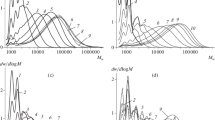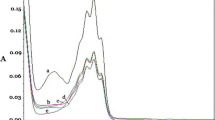Abstract
Reaction conditions for the hydrolysis polymerization of Pu(IV) in a nitric acid solution were studied by a dynamic light scattering method, and the reaction paths of the Pu(IV) hydrolysis polymerization and its thermodynamic functions were calculated. The results showed that the acidity and concentration of Pu(IV) in the solution and the temperature of the solution were correlated with the hydrolysis polymerization of Pu(IV). The particle size distribution of the polymerized Pu(IV) colloidal particles increased with increasing temperature and decreasing Pu(IV) concentration. Quantum chemistry calculations showed that the more likely reaction path of the Pu(IV) hydrolysis polymerization consisted of the following: first, Pu(IV) hydrolysed to form Pu(OH)4 and then polymerized to form a bioxygen-bridged polymer molecule, which had a low reaction energy.










Similar content being viewed by others
References
Nash KL, Lumetta GJ (2011) Advanced separation techniques for nuclear fuel reprocessing. Woodhead Publishing Limited, Cambridge, pp 4–6
Maher K, Bargar JR, Brown GE (2013) Environmental speciation of actinides. Inorg Chem 52(7):3510–3532
Choppin GR, Wong PJ (1998) The chemistry of actinide behavior in marine systems. Aquat Geochem 4(1):77–101
Ikeda-Ohno A, Harrison JJ, Thiruvoth S, Wilsher K, Wong HKY, Johansen MP, Waite TD, Payne TE (2014) Solution speciation of plutonium and Americium at an Australian legacy radioactive waste disposal site. Environ Sci Technol 48(17):10045–10053
Buesseler KO, Kaplan DI, Dai M, Pike S (2009) Source-dependent and source-independent controls on plutonium oxidation state and colloid associations in groundwater. Environ Sci Technol 43(5):1322–1328
Edelstein NM, Fuger J, Morss LR (2006) The chemistry of the actinide and transactinide elements. Springer, Cham
Levchuk S, Kashparov V, Maloshtan I, Yoschenko V, Van Meir N (2012) Appl Geochem 27:1339
Novikov AP, Kalmykov SN, Utsunomiya S, Ewing RC, Horreard F, Merkulov A, Clark SB, Tkachev VV, Myasoedov BF (2006) Science 314:638
Paviet-Hartmann P, Senentz G (2007) Prevention of Pu(IV) polymerization in a PUREX-based process. In: Paper presented at the Global 2007, Boise, Idaho
Costanzo DA, Biggers RE, Bell JT (1973) Plutonium polymerization—I A spectrophotometric study of the polymerization of plutonium(IV). J Inorg Nucl Chem 35(2):609–622
Schuelein VL (1975) Parameters for plutonium polymer formation in nitric acid. In: American Chemical Soiety 30th northwest regional meeting ARH-SA-233
Brunstad A (1959) Polymerization and precipitation of plutonium(IV) in nitric acid. Ind Eng Chem 51(1):38–40
Bell JT, Costanzo DA, Biggers RE (1973) Plutonium polymerization—II Kinetics of the plutonium polymerization. J Inorg Nucl Chem 35:623–628
Yu M, Kulyako SA, Perevalov TTI (2009) Disproportionation of polymeric Pu(IV) in weakly acidic solutions. Radiochemistry 51(4):368–372
Xie J, Wang Y, Lin J, Li M, Zhang J (2015) Trace-level plutonium(IV) polymer stability and its transport in coarse-grained granites. Chem Geol 398:1–10
Liang H, Chen G, Gu F (2013) Comput Theor Chem 1010:1–10
Tsushima S, Yang T, Suzuki A (2001) Theoretical Gibbs free energy study on UO2(H2O)n2+ and its hydrolysis products. Chem Phys Lett 334:365–373
Hao D (2007) Theoretical study on the reaction mechanism of several important free radicals and molecules in the environment [D], 2005. Jilin University
Xiao-ling S, Xu-hui H, Yue-piao C, Chao-jie W (2013) J Nucl Radiochem 35(5):303–310
Odoh SO, Schrenckenbach G (2011) J Phys Chem A 115(48):14110–14119
Author information
Authors and Affiliations
Corresponding author
Ethics declarations
Conflict of interest
The authors declare that they have no conflict of interest.
Additional information
Publisher's Note
Springer Nature remains neutral with regard to jurisdictional claims in published maps and institutional affiliations.
Rights and permissions
About this article
Cite this article
Zhang, H., Chen, J., Ning, Yz. et al. An analysis of the hydrolytic polymerization of Pu(IV) and its reaction paths in nitric acid solution. J Radioanal Nucl Chem 327, 199–206 (2021). https://doi.org/10.1007/s10967-020-07494-x
Received:
Accepted:
Published:
Issue Date:
DOI: https://doi.org/10.1007/s10967-020-07494-x




